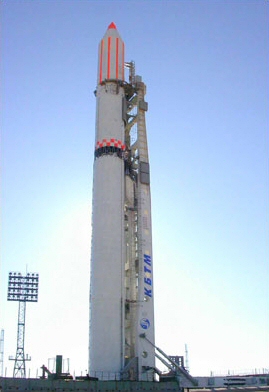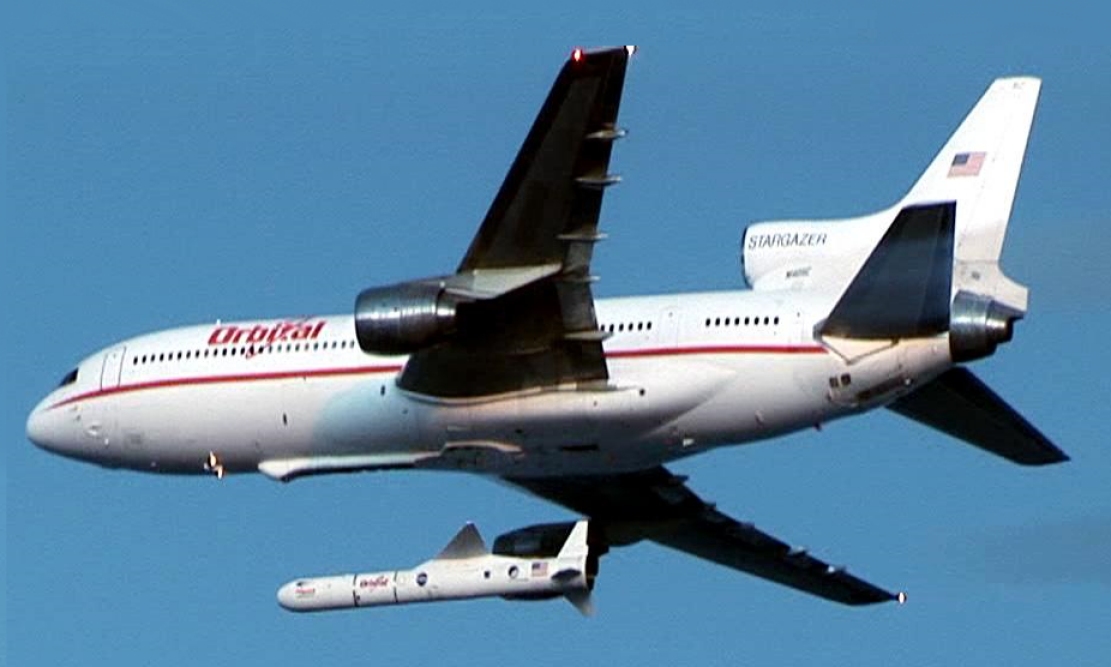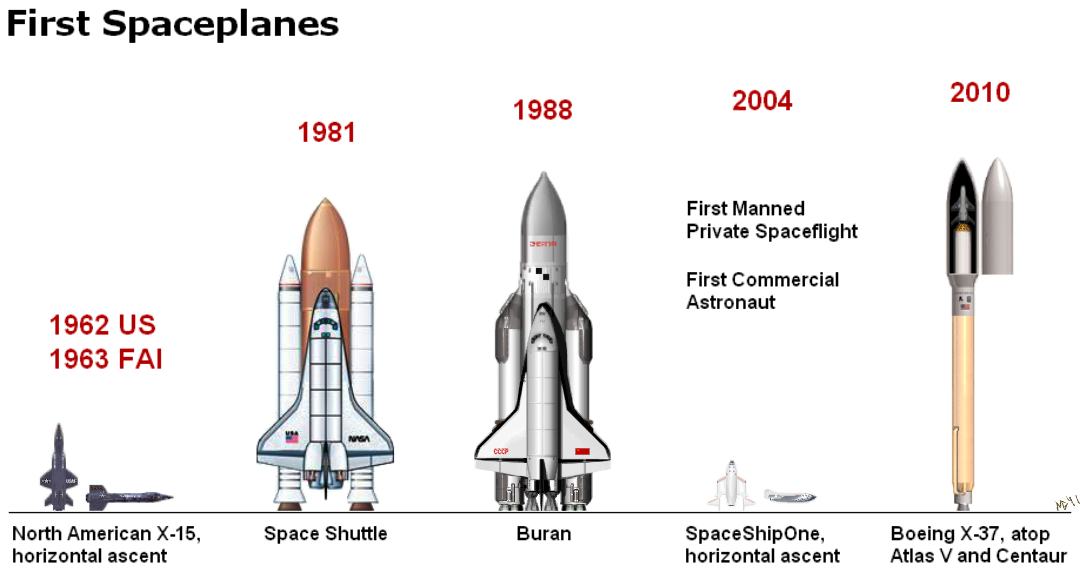|
MAKS (spacecraft)
The MAKS (Multipurpose aerospace system) (Russian: МАКС (Многоцелевая авиационно-космическая система)) is a Soviet air-launched orbiter reusable launch system project that was proposed in 1988, but cancelled in 1991. The MAKS orbiter was supposed to reduce the cost of transporting materials to Earth orbit by a factor of ten. The reusable orbiter and its external expendable fuel tank would have been launched by an Antonov AN-225 airplane, developed by Antonov ASTC (Kyiv, Ukraine). Had it been built, the system would have weighed and been capable of carrying a payload. Three variants of the MAKS system were conceived: MAKS-OS, the standard configuration with the orbiter on top of the fuel tank; MAKS-T, with upgraded payload capability and a configuration that involved the fuel tank above the orbiter; and MAKS-M, a version that included its fuel tank within the envelope of the orbiter. As of June of 2010, Russia was considering reviving ... [...More Info...] [...Related Items...] OR: [Wikipedia] [Google] [Baidu] |
Antonov An-225
The Antonov An-225 Mriya ( uk, Антонов Ан-225 Мрія, lit=dream' or 'inspiration; NATO reporting name: Cossack) was a strategic airlift cargo aircraft designed and produced by the Antonov Design Bureau in the Soviet Union. It was originally developed during the 1980s as an enlarged derivative of the Antonov An-124 airlifter for the express purpose of transporting ''Buran''-class orbiters. On 21 December 1988, the An-225 performed its maiden flight; only a single example was ever completed, although a second airframe with a slightly different configuration was partially built. After a brief period of use supporting the Soviet space program, the aircraft was mothballed during the early 1990s. Towards the turn of the century, it was decided to refurbish the An-225 and reintroduced it for commercial operations, carrying oversized payloads for the operator Antonov Airlines. Multiple announcements were made regarding the potential completion of the second airframe, howe ... [...More Info...] [...Related Items...] OR: [Wikipedia] [Google] [Baidu] |
Soviet Space Program
The Soviet space program (russian: Космическая программа СССР, Kosmicheskaya programma SSSR) was the national space program of the former Union of Soviet Socialist Republics (USSR), active from 1955 until the dissolution of the Soviet Union in 1991. Soviet investigations in rocketry began with the formation of a research laboratory in 1921, but these efforts were hampered by the devastating war with Germany. Competing in the Space Race with the United States and later with the European Union and China, the Soviet program was notable in setting many records in space exploration, including the first intercontinental missile that launched the first satellite and sent the first animal into Earth orbit in 1957, and placed the first human in space in 1961. In addition, the Soviet program also saw the first woman in space in 1963 and a cosmonaut performing the first spacewalk in 1965. Other milestones included computerized robotic missions exploring t ... [...More Info...] [...Related Items...] OR: [Wikipedia] [Google] [Baidu] |
Low Earth Orbit
A low Earth orbit (LEO) is an orbit around Earth with a period of 128 minutes or less (making at least 11.25 orbits per day) and an eccentricity less than 0.25. Most of the artificial objects in outer space are in LEO, with an altitude never more than about one-third of the radius of Earth. The term ''LEO region'' is also used for the area of space below an altitude of (about one-third of Earth's radius). Objects in orbits that pass through this zone, even if they have an apogee further out or are sub-orbital, are carefully tracked since they present a collision risk to the many LEO satellites. All crewed space stations to date have been within LEO. From 1968 to 1972, the Apollo program's lunar missions sent humans beyond LEO. Since the end of the Apollo program, no human spaceflights have been beyond LEO. Defining characteristics A wide variety of sources define LEO in terms of altitude. The altitude of an object in an elliptic orbit can vary significantly along the orbit. ... [...More Info...] [...Related Items...] OR: [Wikipedia] [Google] [Baidu] |
Reusable Launch System
A reusable launch vehicle have parts that can be recovered and reflown, while carrying payloads from the surface to outer space. Rocket stages are the most common launch vehicle parts aimed for reuse. Smaller parts such as rocket engines and boosters can also be reused, though reusable spacecraft may be launched on top of an expendable launch vehicle. Reusable launch vehicles do not need to make these parts for each launch, therefore reducing its launch cost significantly. However, these benefits are diminished by the cost of recovery and refurbishment. Reusable launch vehicles may contain additional avionics and propellant, making them heavier than their expendable counterparts. Reused parts may need to enter the atmosphere and navigate through it, so they are often equipped with heat shields, grid fins, and other flight control surfaces. By modifying their shape, spaceplanes can leverage aviation mechanics to aid in its recovery, such as gliding or lift. In the atmosphere, par ... [...More Info...] [...Related Items...] OR: [Wikipedia] [Google] [Baidu] |
Antonov
Antonov State Enterprise ( uk, Державне підприємство «Антонов»), formerly the Aeronautical Scientific-Technical Complex named after Antonov (Antonov ASTC) ( uk, Авіаційний науково-технічний комплекс імені Антонова, �НТК ім. Антонова}), and earlier the Antonov Design Bureau, for its chief designer, Oleg Antonov, is a Ukrainian aircraft manufacturing and services company. Antonov's particular expertise is in the fields of very large aeroplanes and aeroplanes using unprepared runways. Antonov (model prefix "An-") has built a total of approximately 22,000 aircraft, and thousands of its planes are operating in the former Soviet Union and in developing countries. Antonov StC is a state-owned commercial company. Its headquarters and main industrial grounds were originally located in Novosibirsk, and in 1952 were transferred to Kyiv. On 12 May 2015 it was transferred from the Ministry of Economi ... [...More Info...] [...Related Items...] OR: [Wikipedia] [Google] [Baidu] |
Kiev
Kyiv, also spelled Kiev, is the capital and most populous city of Ukraine. It is in north-central Ukraine along the Dnieper, Dnieper River. As of 1 January 2021, its population was 2,962,180, making Kyiv the List of European cities by population within city limits, seventh-most populous city in Europe. Kyiv is an important industrial, scientific, educational, and cultural center in Eastern Europe. It is home to many High tech, high-tech industries, higher education institutions, and historical landmarks. The city has an extensive system of Transport in Kyiv, public transport and infrastructure, including the Kyiv Metro. The city's name is said to derive from the name of Kyi, one of its four legendary founders. During History of Kyiv, its history, Kyiv, one of the oldest cities in Eastern Europe, passed through several stages of prominence and obscurity. The city probably existed as a commercial center as early as the 5th century. A Slavs, Slavic settlement on the great trade ... [...More Info...] [...Related Items...] OR: [Wikipedia] [Google] [Baidu] |
Ukraine
Ukraine ( uk, Україна, Ukraïna, ) is a country in Eastern Europe. It is the second-largest European country after Russia, which it borders to the east and northeast. Ukraine covers approximately . Prior to the ongoing Russian invasion, it was the eighth-most populous country in Europe, with a population of around 41 million people. It is also bordered by Belarus to the north; by Poland, Slovakia, and Hungary to the west; and by Romania and Moldova to the southwest; with a coastline along the Black Sea and the Sea of Azov to the south and southeast. Kyiv is the nation's capital and largest city. Ukraine's state language is Ukrainian; Russian is also widely spoken, especially in the east and south. During the Middle Ages, Ukraine was the site of early Slavic expansion and the area later became a key centre of East Slavic culture under the state of Kievan Rus', which emerged in the 9th century. The state eventually disintegrated into rival regional po ... [...More Info...] [...Related Items...] OR: [Wikipedia] [Google] [Baidu] |
State Space Agency Of Ukraine
The State Space Agency of Ukraine (SSAU; uk, Державне космічне агентство України, ''Derzhavne kosmichne ahentstvo Ukrayiny'', ДКАУ, ''DKAU'') is the Ukrainian government agency responsible for space policy and programs. Along with the Ukrainian Defense Industry and the Antonov Aeronautical Scientific-Technical Complex, it is a major state complex of the national defense industry of Ukraine.The agency was formed in 1992 based on the Soviet space program infrastructure remaining in Ukraine following the dissolution of the Soviet Union. The State Space Agency of Ukraine does not specialize in crewed astronautical programs. It is the second of two direct Soviet space program descendants. The Ukrainian city of Dnipro, also known as the Rocket City, during Soviet period was one of the Soviet space rocket manufacturing centers, while the cities of Kyiv and Kharkiv provided various other technological support. Those remnants of the Soviet space prog ... [...More Info...] [...Related Items...] OR: [Wikipedia] [Google] [Baidu] |
Air Launch To Orbit
Air launch to orbit (ALTO) is the method of launching smaller rockets at altitude from a heavier conventional horizontal-takeoff aircraft, to carry satellites to low Earth orbit. It is a follow-on development of air launches of experimental aircraft that began in the late 1940s. This method, when employed for orbital payload insertion, presents significant advantages over conventional vertical rocket launches, particularly because of the reduced mass, thrust, cost of the rocket, geographical factors and natural disasters. Air launching has also been developed for sub-orbital spaceflight. In 2004 the Ansari X Prize $10 Million purse was won by a team led by Burt Rutan's Scaled Composites, launching the SpaceShipOne from the purpose-built White Knight carrier aircraft. Advantages The principal advantage of a rocket being launched by a high flying airplane is that it needs not fly through the low, dense atmosphere, the drag of which requires a considerable amount of extra work a ... [...More Info...] [...Related Items...] OR: [Wikipedia] [Google] [Baidu] |
Buran Programme
The ''Buran'' program (russian: Буран, , "Snowstorm", "Blizzard"), also known as the "VKK Space Orbiter program" (russian: ВКК «Воздушно-Космический Корабль», lit=Air and Space Ship), was a Soviet and later Russian reusable spacecraft project that began in 1974 at the Central Aerohydrodynamic Institute in Moscow and was formally suspended in 1993. In addition to being the designation for the whole Soviet/Russian reusable spacecraft project, ''Buran'' was also the name given to Orbiter K1, which completed one uncrewed spaceflight in 1988 and was the only Soviet reusable spacecraft to be launched into space. The ''Buran''-class orbiters used the expendable Energia rocket as a launch vehicle. Unlike the Space Shuttle, Buran had a capability of flying uncrewed missions, as well as performing fully automated landings. The Buran program was started by the Soviet Union as a response to the United States Space Shuttle program. The project was the l ... [...More Info...] [...Related Items...] OR: [Wikipedia] [Google] [Baidu] |
RD-701
The RD-701 (''russian: Раке́тный дви́гатель 701'', Rocket Engine 701) is a liquid-fuel rocket engine developed by Energomash, Russia (USSR at that time). It was briefly proposed to propel the reusable MAKS space plane, but the project was cancelled shortly before the end of USSR. The ''RD-701'' is a tripropellant engine that uses a staged combustion cycle with afterburning of oxidizer-rich hot turbine gas. The RD-701 has two modes. ''Mode 1'' uses three components: LOX as an oxidizer and a fuel mixture of RP-1 / LH2 which is used in the lower atmosphere. ''Mode 2'' also uses LOX, with LH2 as fuel in vacuum where atmospheric influence is negligible. The use of less dense fuel components at maximum efficiency conditions allows minimizing the volume of fuel tanks and subsequently their mass down to 30%. The ''RD-701'' was developed into the RD-704 with one combustion chamber. The RD-701 is derived from the hydrogen fueled RD-0120. It is essentially two engines wit ... [...More Info...] [...Related Items...] OR: [Wikipedia] [Google] [Baidu] |
Proposed Spacecraft
Proposal(s) or The Proposal may refer to: * Proposal (business) * Research proposal * Proposal (marriage) * Proposition, a proposal in logic and philosophy Arts, entertainment, and media * ''The Proposal'' (album) Films * ''The Proposal'' (1957 film), an Australian television play based on Chekhov's 1890 play * ''The Proposal'' (2001 film), starring Nick Moran, Jennifer Esposito, and Stephen Lang * ''The Proposal'' (2009 film), starring Sandra Bullock and Ryan Reynolds * ''The Proposal'' (2022 film), starring Joe Joseph and Amara Raja * " La propuesta" ("The Proposal"), a short story in the 2014 Argentina anthology film ''Wild Tales'' Literature * ''Proposals (play)'', a 1997 play by Neil Simon * ''The Proposal'' (novel), 1999 and 35th book in the ''Animorphs'' series by K.A. Applegate * ''The Proposal'', alternative title of Chekhov's 1890 play ''A Marriage Proposal'' Television * ''The Proposal'' (American TV series), a 2018 reality dating series * The Proposal (Aust ... [...More Info...] [...Related Items...] OR: [Wikipedia] [Google] [Baidu] |


.jpg)

.jpg)


